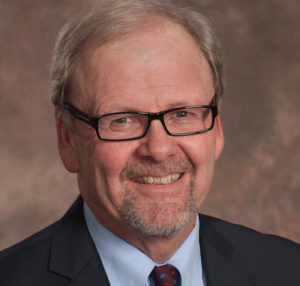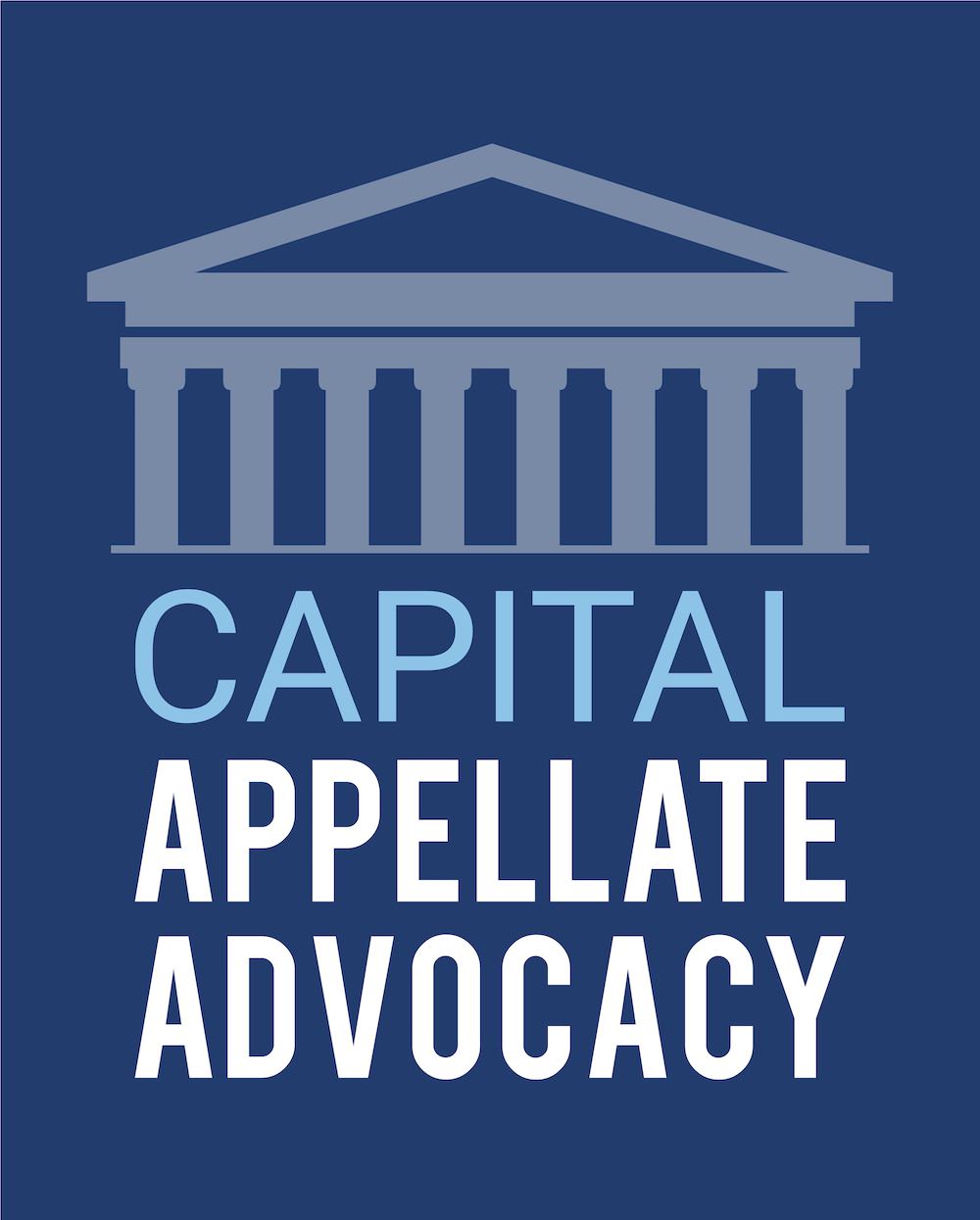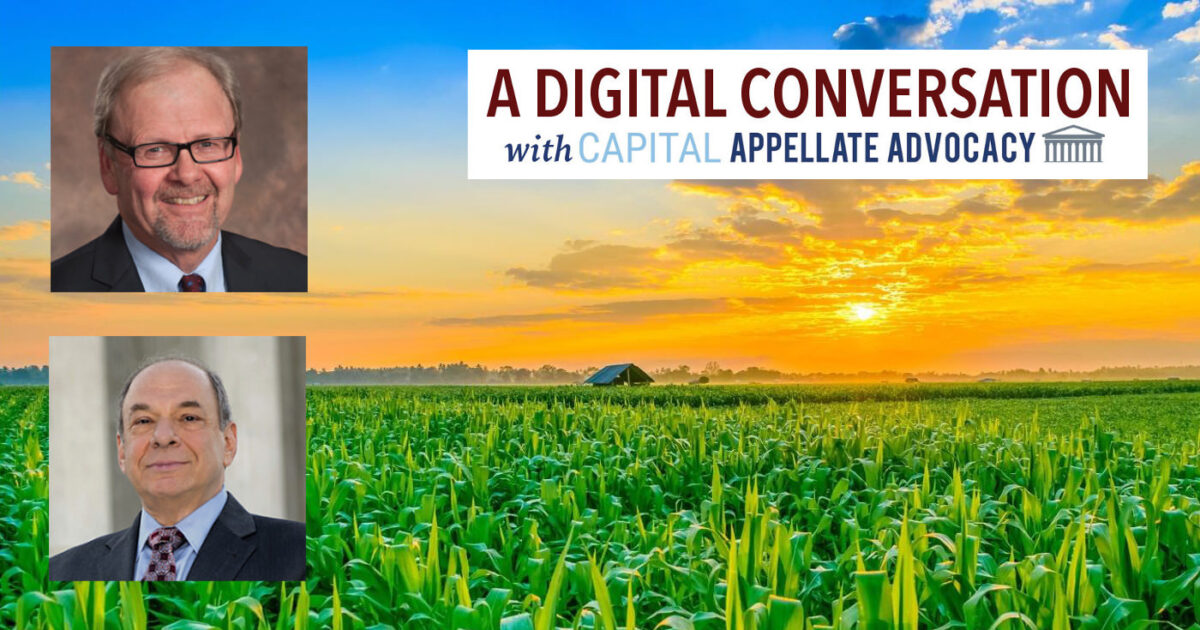Jay Vroom probably knows as much about the issues confronting the agricultural industry—“agribusiness”—as most anyone in Washington, D.C. In 2018 he stepped down as President and CEO of CropLife America, where he represented the nation’s crop protection pesticide and biotechnology innovators, producers, and distributors for three decades.
Earlier in Jay’s career—after growing up on his family’s farm and graduating with honors from the College of Agriculture at the University of Illinois Urbana-Champaign—he held executive positions at the Merchants Exchange of St. Louis, the association now known as the Agricultural Retailers Association, and The Fertilizer Institute.
Over the years I have been privileged to work with Jay and his CropLife America colleagues on a variety of pesticide-related litigation and regulatory matters. Now that Jay, like I, has decided to become an independent professional, I thought this would be a good time to catch up with him about his current activities. And in light of Jay’s extensive knowledge and experience, I also wanted to ask him to share some of his insights, especially regarding the relationship between agribusiness and government regulators.

Larry Ebner: Jay, since departing CropLife America, you have been serving as a strategic consultant for several agribusiness organizations and companies. Can you describe the types of services that you are providing and highlight of some of your current projects?
Jay Vroom: Thanks Larry! First I want to thank the members of CropLife for the wonderful decades I enjoyed working for them. They are the most innovative collection of companies contributing to the advancement of environmental improvement, food, and farming on earth—and I was honored to represent them, work with them, and help them find consensus on issues that the public cares about. And I want to thank the countless staff colleagues and external consultants who made up a phenomenal team of which I was privileged to be a part.
In my “new career” after CLA, I’m enjoying working for a variety of ag and food companies—many in the ag tech space, helping them sort through regulatory compliance challenges. I am also honored to serve as an advisor to Farm Journal and Farm Journal Foundation, helping with two significant USDA-related initiatives: (1) advancing the deployment of the garden at the USDA headquarters into a more targeted outreach tool for many of the 20+ million visitors to the National Mall every year, and (2) helping the Natural Resources Conservation Service (NRCS) expand the reach of conservation programs—to take conservation farming to the next level for American farmers. And some of my work focuses on helping farmer interests in the advancement of biofuels markets.
I’m also grateful to be able to work inside great consultancies like DCLRS, Inc., OFW Law, The Context Network, and FLM Harvest to help a wide array of client companies and associations.
Larry Ebner: What are the key agribusiness-related issues currently on federal and state legislators’ and regulators’ radar screens?
Jay Vroom: TRADE, Larry. Almost nothing comes close to the sweeping impacts of US trade policy on agribusiness in its current iteration. Of course, we all know that the “trade wars” are a burden on the value of commodities that farmers grow—and that the depressed farm income hits all in the agribusiness community. But many inputs that farmers use come from places (mainly China) where new tariff charges apply—all this is quite disruptive to planned 2019 and 2020 business. Congressional approval of the new North American trade pact—the “USMCA”—is critically important right now.
Likewise, the European “precautionary principle” is resulting in many pesticides failing new EU cutoff criteria—and then subsequent removal from use by EU farmers and eventual loss of import tolerances for those same products on or in farm products imported into the EU. This is shaping up to potentially be the largest non-tariff trade barrier in history. Farm trade interests and governments of exporting nations are pushing back, but it’s hard to see any immediate or easy outcomes.
New regulations for the advent of “gene editing” are an important guidepost for the potential of that new science—and new regulations as mandated in the 2018 Farm Bill for the guidance of new and traditional biostimulant products are also underway.
And of course, evolving science is pushing new needs in traditional regulation of both synthetic pesticides and biopesticides—all of which are very significant. For example, computational toxicology is evolving the balance between in-vivo and in-vitro scientific testing, resulting in cutting-edge regulatory process changes. New ag inputs derived from synthetic biology are also testing traditional regulatory processes.
Larry Ebner: In what ways have you seen US EPA’s scientific assessment and mitigation of potential pesticide risks change or evolve?
Jay Vroom: Well, the aforementioned developments in 21st Century toxicology are huge drivers of how pesticide risk assessment and regulation is changing. Some very innovative new products are also challenging regulators to think differently about how to apply or evolve old risk assessment tools to work with new product profiles—and given what I’ve seen coming out of some innovation start-up companies, the pace of that sort of challenge to EPA and other regulators will do nothing but accelerate in coming years.
And the rapidly expanding field of genome mapping and understanding will afford regulators new ways to evaluate risk—and regulate ever-smarter.
I’m impressed with how well regulators are keeping up with many of these changes—unfortunately political science seems to be pulling the other way.
Larry Ebner: What are your thoughts about state regulation of pesticides, especially in California?
Jay Vroom: California has always had a penchant for wanting to be “first” to bring regulatory solutions. That State is a massive entity—probably the 7th or 8th largest economy on the face of the earth, and the largest state ag economy in the USA. It has both the resources to have a very large government and some clearly unique aspects in its climate and geography to warrant specialized regulation.
But California has an even more unique and complex political landscape— which has resulted in clear over-regulation and over-warning (such as ubiquitous warnings under Proposition 65). In many cases this only adds burden to its economy and makes it difficult for people and businesses in other states and countries to participate in commerce with California.
Thanks to an effective federal regulatory scheme for pesticides, there has been some containment of the out-of-control regulatory environment of California—but those limits have limits, and it’s hard to see when these challenges abate for pesticide regulation and a whole host of other food and ag regulatory and litigation matters.
Larry Ebner: Do you see any beneficial role that counties, cities, and other local governments can play regarding sale or use of pesticides?
Jay Vroom: Local units of government do have obligations to provide representative voice to their residents and citizens. But in the case of managing pesticide risks, local governments’ function should be to help amplify local concerns and needs so that state and federal regulators can use their expert staffs and other resources to focus on local problems and seek appropriate solutions.
We could use a restoration of some preemption-of-local-regulation for all ag-tech and public health products—and I am hopeful that the associations and other groups that represent those sectors will keep looking for creative and effective ways to restore that kind of crucial public policy.
Larry Ebner: Based on your 45 years of experience in the trade association world, what are the most effective ways that industry organizations can interact with each branch of government—executive, legislative, and judicial?
Jay Vroom: Larry, the answer to that question is probably the most important element for effective advocacy. And the simplest answer may be the most difficult to implement. It is simply UNITY of message and delivery, whether in the form of advocating for proposed legislation or regulation, or as intervenors or amicus curiae in key litigation affecting industry.
The fewer, better solutions that are advocated as the solution to an issue, the greater the chance that government or courts will adopt the right policy. With so many different but aligned stakeholders around ag tech issues, it can be very challenging to get players to see the ultimate benefit of working so closely together. It is very hard work—but it is the only way to achieve success.
Larry Ebner: What about public interest groups? What are the best ways for industry associations, and individual companies, to interact with them?
Jay Vroom: That’s a great question! When we prepared for the 50-year anniversary of Rachel Carson’s book “Silent Spring” in 2012, we spent some quality time thinking about what the modern environmental movement has meant to US agriculture. My conclusion: despite our considerable disagreements with some environmentalist groups over many key public health and environmental policies, US agriculture is better off because of what Rachel Carson helped to launch. Without that societal sector we likely would not have the EPA—and the EPA has generally been a place where science has driven public policy outcomes on crop protection products.
So my answer is that US agriculture should continue to engage the public interest groups proactively as organizations and to seek ways to be actively involved in some of those groups as members in our own right. There are many “moderate” NGOs that we can engage.
The successful enactment almost 20 years ago of the first version of pesticide fee-for-service legislation, “PRIA,” was because the then EPA Assistant Administrator for pesticides, Steve Johnson, brought a small representative group of ag and NGO stakeholders together and challenged us to work out a compromise solution. The reason that PRIA reauthorization got delayed in 2018 was because that original unique coalition broke down.
For sure, there are also many NGOs that are not reasonable and have objectives that can never align with modern agriculture—but that should not prevent outreach to the others.
Larry Ebner: You and I worked for many years on behalf of CropLife America and its members to establish a FIFRA-based federal preemption defense for pesticide-related “failure to warn” suits. We were successful until 2005 when the U.S. Supreme Court curtailed the defense. Do you have any reflections on those efforts? If the right case comes along, do you think that the Supreme Court should be urged to revisit the issue?
Jay Vroom: I certainly hope that the Supreme Court would revisit FIFRA preemption, and I think such a moment would be informed by the earlier experiences in advocating protective preemption for pesticide manufacturers, distributors and users. Some of the earlier cases had some inherent weaknesses which might be improved in a future case—and I also believe that there are some limited opportunities for Congress and the Administration to shore up the statutory authorities for preemption, as I alluded to earlier. All these aspects deserve continued attention and effort from everyone in agriculture.
Pesticide tort preemption does not and should not mean exemption from all product liability—in the FIFRA context I think it has always stood for reasonable policy to allow EPA to use its highly sophisticated scientific and administrative expertise to regulate the content of nationally uniform pesticide product labeling. It is a dose of common sense. Since FIFRA explicitly preempts states from regulating the content of pesticide labeling, including warnings and precautionary statements, juries should not have that power either.
One set of product liability litigation that’s currently active across a wide array of courts and case filings may be the “elephant in the room” that forces governments to bring some measure of common sense back to this crucial public policy arena. I’m of course referring to the glyphosate matter—which appears to me to be impossible to simply ignore and allow to play out.
Larry Ebner: Finally, on a more positive note, what do you consider to be among your greatest successes steering and advising agribusiness and its various sectors?
Jay Vroom: I think is it is clear—any success I had in my 45 year-long trade association career was always linked to coalition building. When things got done to help food and farming interests, it was because almost everybody came together— and almost always it took a long time to get those successes over the finish line. So keeping alignment was as important as getting alignment in the first place.
Passing the Food Quality Protection Act (FQPA) was an 8-year coalition effort led by the Food Chain Coalition of which we at CLA were leaders. Efforts to drive to a solution to the Endangered Species Act (ESA) challenges to FIFRA are effective because a broad base of industry and grower organizations along with some key environmental NGOs have worked hard together. A solution is still possible on the ESA front, but only if people work together.
Larry Ebner: Jay, thanks so much for participating in this digital conversation, and for your tremendous insights. I’m certain that it will provoke a lot of thought. For readers who would like to follow up, what is the best way to contact you?
Jay Vroom: Folks can reach me by email at jayjohnvroom@gmail.com and by phone/text at 202 427-7932.

